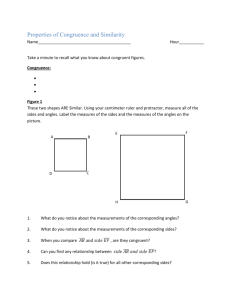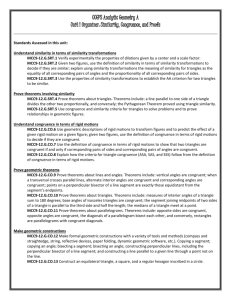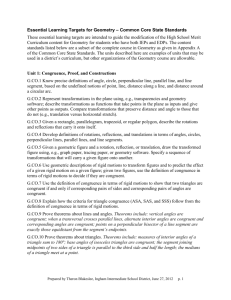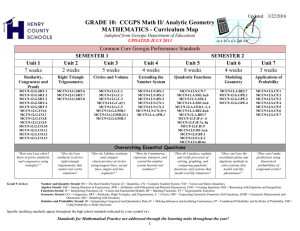Standards and Video Tutorials
advertisement
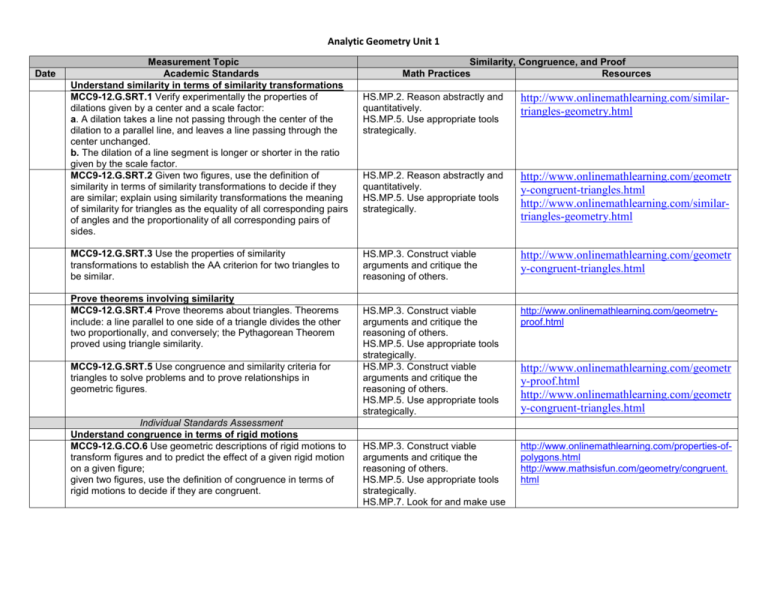
Analytic Geometry Unit 1 Date Measurement Topic Academic Standards Understand similarity in terms of similarity transformations MCC9-12.G.SRT.1 Verify experimentally the properties of dilations given by a center and a scale factor: a. A dilation takes a line not passing through the center of the dilation to a parallel line, and leaves a line passing through the center unchanged. b. The dilation of a line segment is longer or shorter in the ratio given by the scale factor. MCC9-12.G.SRT.2 Given two figures, use the definition of similarity in terms of similarity transformations to decide if they are similar; explain using similarity transformations the meaning of similarity for triangles as the equality of all corresponding pairs of angles and the proportionality of all corresponding pairs of sides. MCC9-12.G.SRT.3 Use the properties of similarity transformations to establish the AA criterion for two triangles to be similar. Prove theorems involving similarity MCC9-12.G.SRT.4 Prove theorems about triangles. Theorems include: a line parallel to one side of a triangle divides the other two proportionally, and conversely; the Pythagorean Theorem proved using triangle similarity. MCC9-12.G.SRT.5 Use congruence and similarity criteria for triangles to solve problems and to prove relationships in geometric figures. Individual Standards Assessment Understand congruence in terms of rigid motions MCC9-12.G.CO.6 Use geometric descriptions of rigid motions to transform figures and to predict the effect of a given rigid motion on a given figure; given two figures, use the definition of congruence in terms of rigid motions to decide if they are congruent. Similarity, Congruence, and Proof Math Practices Resources HS.MP.2. Reason abstractly and quantitatively. HS.MP.5. Use appropriate tools strategically. http://www.onlinemathlearning.com/similartriangles-geometry.html HS.MP.2. Reason abstractly and quantitatively. HS.MP.5. Use appropriate tools strategically. http://www.onlinemathlearning.com/geometr y-congruent-triangles.html http://www.onlinemathlearning.com/similartriangles-geometry.html HS.MP.3. Construct viable arguments and critique the reasoning of others. http://www.onlinemathlearning.com/geometr y-congruent-triangles.html HS.MP.3. Construct viable arguments and critique the reasoning of others. HS.MP.5. Use appropriate tools strategically. HS.MP.3. Construct viable arguments and critique the reasoning of others. HS.MP.5. Use appropriate tools strategically. http://www.onlinemathlearning.com/geometryproof.html HS.MP.3. Construct viable arguments and critique the reasoning of others. HS.MP.5. Use appropriate tools strategically. HS.MP.7. Look for and make use http://www.onlinemathlearning.com/properties-ofpolygons.html http://www.mathsisfun.com/geometry/congruent. html http://www.onlinemathlearning.com/geometr y-proof.html http://www.onlinemathlearning.com/geometr y-congruent-triangles.html Analytic Geometry Unit 1 MCC9-12.G.CO.7 Use the definition of congruence in terms of rigid motions to show that two triangles are congruent if and only if corresponding pairs of sides and corresponding pairs of angles are congruent. MCC9-12.G.CO.8 Explain how the criteria for triangle congruence (ASA, SAS, and SSS) follow from the definition of congruence in terms of rigid motions. Prove geometric theorems MCC9-12.G.CO.9 Prove theorems about lines and angles. Theorems include: vertical angles are congruent; when a transversal crosses parallel lines, alternate interior angles are congruent and corresponding angles are congruent; points on a perpendicular bisector of a line segment are exactly those equidistant from the segment’s endpoints. MCC9-12.G.CO.10 Prove theorems about triangles. Theorems include: measures of interior angles of a triangle sum to 180 degrees; base angles of isosceles triangles are congruent; the segment joining midpoints of two sides of a triangle is parallel to the third side and half the length; the medians of a triangle meet at a point. MCC9-12.G.CO.11 Prove theorems about parallelograms. Theorems include: opposite sides are congruent, opposite angles are congruent, the diagonals of a parallelogram bisect each other, and conversely, rectangles are parallelograms with congruent diagonals. Make geometric constructions MCC9-12.G.CO.12 Make formal geometric constructions with a variety of tools and methods (compass and straightedge, string, reflective devices, paper folding, dynamic geometric software, etc.). Copying a segment; copying an angle; bisecting a segment; bisecting an angle; constructing perpendicular lines, including the perpendicular bisector of a line segment; and constructing a line parallel to a given line through a point not on the line. MCC9-12.G.CO.13 Construct an equilateral triangle, a square, and a regular hexagon inscribed in a circle. of structure. HS.MP.3. Construct viable arguments and critique the reasoning of others. http://www.onlinemathlearning.com/properties-ofpolygons.html http://www.amathsdictionaryforkids.com/dictionar y.html HS.MP.3. Construct viable arguments and critique the reasoning of others. http://www.onlinemathlearning.com/geometry -congruent-triangles.html HS.MP.3. Construct viable arguments and critique the reasoning of others. HS.MP.5. Use appropriate tools strategically. http://www.onlinemathlearning.com/geometryproof.html HS.MP.5. Use appropriate tools strategically. HS.MP.6. Attend to precision. http://www.onlinemathlearning.com/geometryconstructions.html http://www.onlinemathlearning.com/geometryconstructions-2.html http://www.onlinemathlearning.com/geometryconstructions-3.html http://www.onlinemathlearning.com/geometryconstructions-4.html http://www.mathsisfun.com/geometry/constructio ns.html http://www.onlinemathlearning.com/parallel-linesgeometry.html Analytic Geometry Unit 1
